Nanocellulose Derivative/Silica Hybrid Core-Shell Chiral Stationary Phase: Preparation and Enantioseparation Performance
Abstract
:1. Introduction
2. Results and Discussion
2.1. Morphology of the Core-Shell Particles
2.2. Pore Structure and Compositional Characterizations of the Core-Shell Particles
2.3. Chiral Separation Performance
2.3.1. Racemic Resolutions under Normal Phase Mode
2.3.2. Racemic Resolutions under Reversed Phase Mode
2.3.3. Solvent Resistance of CPM2 Columns
3. Experimental Section
3.1. Reagents and Materials
3.2. Instrumentations
3.3. Synthesis of NCC Derivatives
3.4. Preparation of the Core-Shell Particles
3.5. Column Packing
4. Conclusions
Supplementary Materials
Acknowledgments
Author Contributions
Conflicts of Interest
Abbreviations
| CPMs | chiral packing materials |
| CSPs | chiral stationary phases |
| HPLC | high performance liquid chromatography |
| MCC | microcrystalline cellulose |
| NCC | nanocrystalline cellulose |
| CTAB | cetyl trimethyl ammonium bromide |
References
- Al-Othman, Z.A.; Al-Warthan, A.; Ali, I. Advances in enantiomeric resolution on monolithic chiral stationary phases in liquid chromatography and electrochromatography. J. Sep. Sci. 2014, 37, 1033–1057. [Google Scholar] [CrossRef] [PubMed]
- Lorenz, H.; Seidel-Morgenstern, A. Processes to separate enantiomers. Angew. Chem. Int. Ed. 2014, 53, 1218–1250. [Google Scholar]
- Lee, G.; Hyun, M. Liquid chromatographic resolution of fendiline and its analogues on a chiral stationary phase based on (+)-(18-crown-6)-2,3,11,12-tetracarboxylic acid. Molecules 2014, 19, 21386–21397. [Google Scholar] [CrossRef] [PubMed]
- Okamoto, Y.; Ikai, T. Chiral HPLC for efficient resolution of enantiomers. Chem. Soc. Rev. 2008, 37, 2593–2608. [Google Scholar] [CrossRef] [PubMed]
- Guo, H.-X.; Wu, S.; Sun, J. Influence of temperature on the enantioselectivity of koga tetraamines on amylose chiral stationary phases. Molecules 2014, 19, 9–21. [Google Scholar] [CrossRef] [PubMed]
- Kong, J.; Zhang, M.; Duan, A.-H.; Zhang, J.-H.; Yang, R.; Yuan, L.-M. Homochiral metal-organic framework used as a stationary phase for high-performance liquid chromatography. J. Sep. Sci. 2015, 38, 556–561. [Google Scholar] [CrossRef] [PubMed]
- Zhang, M.; Zhang, J.-H.; Zhang, Y.; Wang, B.-J.; Xie, S.-M.; Yuan, L.-M. Chromatographic study on the high performance separation ability of a homochiral [Cu2(d-Cam)2(4,4′-bpy)]n based-column by using racemates and positional isomers as test probes. J. Chromatogr. A 2014, 1325, 163–170. [Google Scholar] [CrossRef] [PubMed]
- Kuang, X.; Ma, Y.; Su, H.; Zhang, J.; Dong, Y.-B.; Tang, B. High-performance liquid chromatographic enantioseparation of racemic drugs based on homochiral metal–organic framework. Anal. Chem. 2014, 86, 1277–1281. [Google Scholar] [CrossRef] [PubMed]
- Li, X.; Chang, C.; Wang, X.; Bai, Y.; Liu, H. Applications of homochiral metal-organic frameworks in enantioselective adsorption and chromatography separation. Electrophoresis 2014, 35, 2733–2743. [Google Scholar] [CrossRef] [PubMed]
- Smuts, J.P.; Hao, X.-Q.; Han, Z.; Parpia, C.; Krische, M.J.; Armstrong, D.W. Enantiomeric separations of chiral sulfonic and phosphoric acids with barium-doped cyclofructan selectors via an ion interaction mechanism. Anal. Chem. 2014, 86, 1282–1290. [Google Scholar] [CrossRef] [PubMed]
- Zhao, J.; Lu, X.; Wang, Y.; Lv, J. “Click” preparation of a novel “native-phenylcarbamoylated” bilayer cyclodextrin stationary phase for enhanced chiral differentiation. J. Chromatogr. A 2015, 1381, 253–259. [Google Scholar] [CrossRef] [PubMed]
- Pang, L.; Zhou, J.; Tang, J.; Ng, S.-C.; Tang, W. Evaluation of perphenylcarbamated cyclodextrin clicked chiral stationary phase for enantioseparations in reversed phase high performance liquid chromatography. J. Chromatogr. A 2014, 1363, 119–127. [Google Scholar] [CrossRef] [PubMed]
- Yao, X.; Tan, T.T.Y.; Wang, Y. Thiol–ene click chemistry derived cationic cyclodextrin chiral stationary phase and its enhanced separation performance in liquid chromatography. J. Chromatogr. A 2014, 1326, 80–88. [Google Scholar] [CrossRef] [PubMed]
- Tang, J.; Zhang, S.; Lin, Y.; Zhou, J.; Pang, L.; Nie, X.; Zhou, B.; Tang, W. Engineering cyclodextrin clicked chiral stationary phase for high-efficiency enantiomer separation. Sci. Rep. 2015, 5, 11523. [Google Scholar] [CrossRef] [PubMed]
- Chankvetadze, B. Recent developments on polysaccharide-based chiral stationary phases for liquid-phase separation of enantiomers. J. Chromatogr. A 2012, 1269, 26–51. [Google Scholar] [CrossRef] [PubMed]
- Ikai, T.; Yamamoto, C.; Kamigaito, M.; Okamotoc, Y. Immobilized-type chiral packing materials for HPLC based on polysaccharide derivatives. J. Chromatogr. B Anal. Technol. Biomed. Life Sci. 2008, 875, 2–11. [Google Scholar] [CrossRef] [PubMed]
- Cirilli, R.; Orlando, V.; Ferretti, R.; Turchetto, L.; Silvestri, R.; De Martino, G.; la Torre, F. Direct HPLC enantioseparation of chiral aptazepine derivatives on coated and immobilized polysaccharide-based chiral stationary phases. Chirality 2006, 18, 621–632. [Google Scholar] [CrossRef] [PubMed]
- Loukotková, L.; Rambousková, M.; Bosáková, Z.; Tesařová, E. Cellulose tris(3,5-dimethylphenylcarbamate)-based chiral stationary phases as effective tools for enantioselective HPLC separation of structurally different disubstituted binaphthyls. Chirality 2008, 20, 900–909. [Google Scholar] [CrossRef] [PubMed]
- Ikai, T.; Yamamoto, C.; Kamigaito, M.; Okamotoc, Y. Immobilized polysaccharide derivatives: Chiral packing materials for efficient HPLC resolution. Chem. Rec. 2007, 7, 91–103. [Google Scholar] [CrossRef] [PubMed]
- Shen, J.; Okamoto, Y. Efficient separation of enantiomers using stereoregular chiral polymers. Chem. Rev. 2016, 116, 1094–1138. [Google Scholar] [CrossRef] [PubMed]
- Klemm, D.; Kramer, F.; Moritz, S.; Lindstrom, T.; Ankerfors, M.; Gray, D.; Dorris, A. Nanocelluloses: A new family of nature-based materials. Angew. Chem. 2011, 50, 5438–5466. [Google Scholar] [CrossRef] [PubMed]
- Moon, R.J.; Martini, A.; Nairn, J.; Simonsen, J.; Youngblood, J. Cellulose nanomaterials review: Structure, properties and nanocomposites. Chem. Soc. Rev. 2011, 40, 3941–3994. [Google Scholar] [CrossRef] [PubMed]
- Kelly, J.A.; Giese, M.; Shopsowitz, K.E.; Hamad, W.Y.; MacLachlan, M.J. The development of chiral nematic mesoporous materials. Acc. Chem. Res. 2014, 47, 1088–1096. [Google Scholar] [CrossRef] [PubMed]
- Zhang, J.-H.; Xie, S.-M.; Zhang, M.; Zi, M.; He, P.-G.; Yuan, L.-M. Novel inorganic mesoporous material with chiral nematic structure derived from nanocrystalline cellulose for high-resolution gas chromatographic separations. Anal. Chem. 2014, 86, 9595–9602. [Google Scholar] [CrossRef] [PubMed]
- Zhang, J.H.; Zhang, M.; Xie, S.M.; He, P.G.; Yuan, L.M. A novel inorganic mesoporous material with a nematic structure derived from nanocrystalline cellulose as the stationary phase for high-performance liquid chromatography. Anal. Methods 2015, 7, 3448–3453. [Google Scholar] [CrossRef]
- Zhang, X.L.; Wang, L.T.; Dong, S.Q.; Zhang, X.; Wu, Q.; Zhao, L.; Shi, Y.P. Nonocellulose 3,5-dimethylphenylcarbamate derivative coated chiral stationary phase: Preparation and enantioseparation performance. Chirality 2016. [Google Scholar] [CrossRef] [PubMed]
- Li, C.; Di, B.; Hao, W.; Yan, F.; Su, M. Aminopropyl-functionalized ethane-bridged periodic mesoporous organosilica spheres: Preparation and application in liquid chromatography. J. Chromatogr. A 2011, 1218, 408–415. [Google Scholar] [CrossRef] [PubMed]
- Nicole, L.; Laberty-Robert, C.; Rozes, L.; Sanchez, C. Hybrid materials science: A promised land for the integrative design of multifunctional materials. Nanoscale 2014, 6, 6267–6292. [Google Scholar] [CrossRef] [PubMed]
- Zhang, L.; Liu, J.; Yang, J.; Yang, Q.; Li, C. Direct synthesis of highly ordered amine-functionalized mesoporous ethane-silicas. Microporous Mesoporous Mater. 2008, 109, 172–183. [Google Scholar] [CrossRef]
- Wyndham, K.D.; O’Gara, J.E.; Walter, T.H.; Glose, K.H.; Lawrence, N.L.; Alden, B.A.; Izzo, G.S.; Hudalla, C.J.; Iraneta, P.C. Characterization and evaluation of C18 HPLC stationary phases based on ethyl-bridged hybrid organic/inorganic particles. Anal. Chem. 2003, 75, 6781–6788. [Google Scholar] [CrossRef] [PubMed]
- Zhu, G.; Yang, Q.; Jiang, D.; Yang, J.; Zhang, L.; Li, Y.; Li, C. Synthesis of bifunctionalized mesoporous organosilica spheres for high-performance liquid chromatography. J. Chromatogr. A 2006, 1103, 257–264. [Google Scholar] [CrossRef] [PubMed]
- Wang, L.; Dong, S.; Han, F.; Zhao, Y.; Zhang, X.; Zhang, X.; Qiu, H.; Zhao, L. Spherical beta-cyclodextrin-silica hybrid materials for multifunctional chiral stationary phases. J. Chromatogr. A 2015, 1383, 70–78. [Google Scholar] [CrossRef] [PubMed]
- Weng, X.; Bao, Z.; Zhang, Z.; Su, B.; Xing, H.; Yang, Q.; Yang, Y.; Ren, Q. Preparation of porous cellulose 3,5-dimethylphenylcarbamate hybrid organosilica particles for chromatographic applications. J. Mater. Chem. B 2015, 3, 620–628. [Google Scholar] [CrossRef]
- Rocchi, S.; Rocco, A.; Pesek, J.J.; Matyska, M.T.; Capitani, D.; Fanali, S. Enantiomers separation by nano-liquid chromatography: Use of a novel sub-2 µm vancomycin silica hydride stationary phase. J. Chromatogr. A 2015, 1381, 149–159. [Google Scholar] [CrossRef] [PubMed]
- Zhu, G.; Jiang, D.; Yang, Q.; Yang, J.; Li, C. Trans-(1R,2R)-diaminocyclohexane-functionalized mesoporous organosilica spheres as chiral stationary phase. J. Chromatogr. A 2007, 1149, 219–227. [Google Scholar] [CrossRef] [PubMed]
- Ran, R.; You, L.; Di, B.; Hao, W.; Su, M.; Yan, F.; Huang, L. A novel chiral mesoporous binaphthyl-silicas: Preparation, characterization, and application in HPLC. J. Sep. Sci. 2012, 35, 1854–1862. [Google Scholar] [CrossRef] [PubMed]
- Sinibaldi, M.; Carunchio, V.; Corradini, C.; Girelli, A. High-performance liquid chromatographic resolution of enantiomers on chiral amine-bonded silica gel. Chromatographia 1984, 18, 459–461. [Google Scholar] [CrossRef]
- Gasparrini, F.; Misiti, D.; Pierini, M.; Villani, C. Enantioselective chromatography on brush-type chiral stationary phases containing totally synthetic selectors theoretical aspects and practical applications. J. Chromatogr. A 1996, 724, 79–90. [Google Scholar] [CrossRef]
- Cancelliere, G.; Ciogli, A.; D’Acquarica, I.; Gasparrini, F.; Kocergin, J.; Misiti, D.; Pierini, M.; Ritchie, H.; Simone, P.; Villani, C. Transition from enantioselective high performance to ultra-high performance liquid chromatography: A case study of a brush-type chiral stationary phase based on sub-5-micron to sub-2-micron silica particles. J. Chromatogr. A 2010, 1217, 990–999. [Google Scholar] [CrossRef] [PubMed]
- Ikai, T.; Yamamoto, C.; Kamigaito, M.; Okamoto, Y. Immobilization of polysaccharide derivatives onto silica gel: Facile synthesis of chiral packing materials by means of intermolecular polycondensation of triethoxysilyl groups. J. Chromatogr. A 2007, 1157, 151–158. [Google Scholar] [CrossRef] [PubMed]
- Ikai, T.; Yamamoto, C.; Kamigaito, M.; Okamoto, Y. Organic-inorganic hybrid materials for efficient enantioseparation using cellulose 3,5-dimethylphenylcarbamate and tetraethyl orthosilicate. Chem. Asian J. 2008, 3, 1494–1499. [Google Scholar] [CrossRef] [PubMed]
- Gritti, F.; Guiochon, G. Possible resolution gain in enantioseparations afforded by core-shell particle technology. J. Chromatogr. A 2014, 1348, 87–96. [Google Scholar] [CrossRef] [PubMed]
- Wu, X.; You, L.; Di, B.; Hao, W.; Su, M.; Gu, Y.; Shen, L. Novel chiral core-shell silica microspheres with trans-(1R,2R)-diaminocyclohexane bridged in the mesoporous shell: Synthesis, characterization and application in high performance liquid chromatography. J. Chromatogr. A 2013, 1299, 78–84. [Google Scholar] [CrossRef] [PubMed]
- Hayes, R.; Ahmed, A.; Edge, T.; Zhang, H. Core-shell particles: Preparation, fundamentals and applications in high performance liquid chromatography. J. Chromatogr. A 2014, 1357, 36–52. [Google Scholar] [CrossRef] [PubMed]
- Lomsadze, K.; Jibuti, G.; Farkas, T.; Chankvetadze, B. Comparative high-performance liquid chromatography enantioseparations on polysaccharide based chiral stationary phases prepared by coating totally porous and core–shell silica particles. J. Chromatogr. A 2012, 1234, 50–55. [Google Scholar] [CrossRef] [PubMed]
- Sample Availability: Samples are available from the authors.
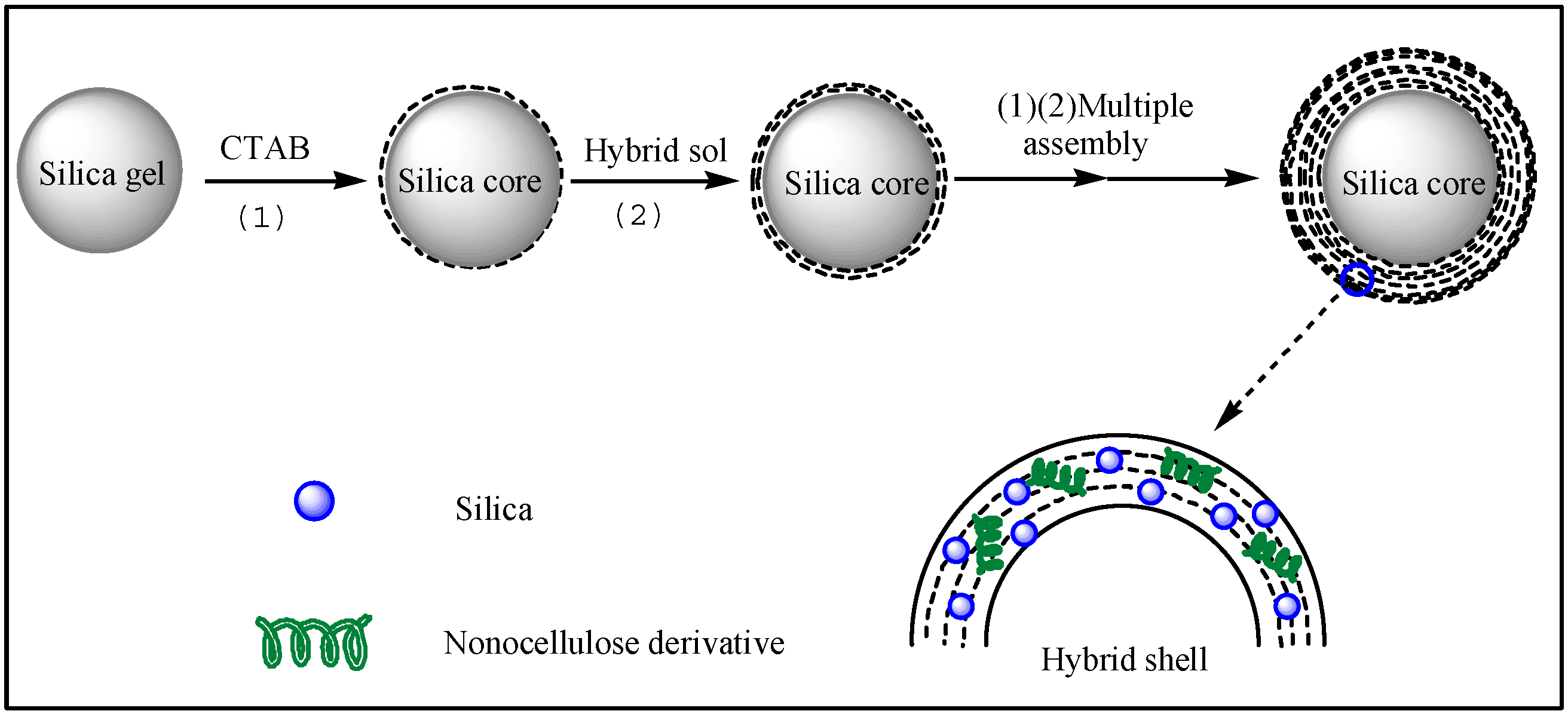
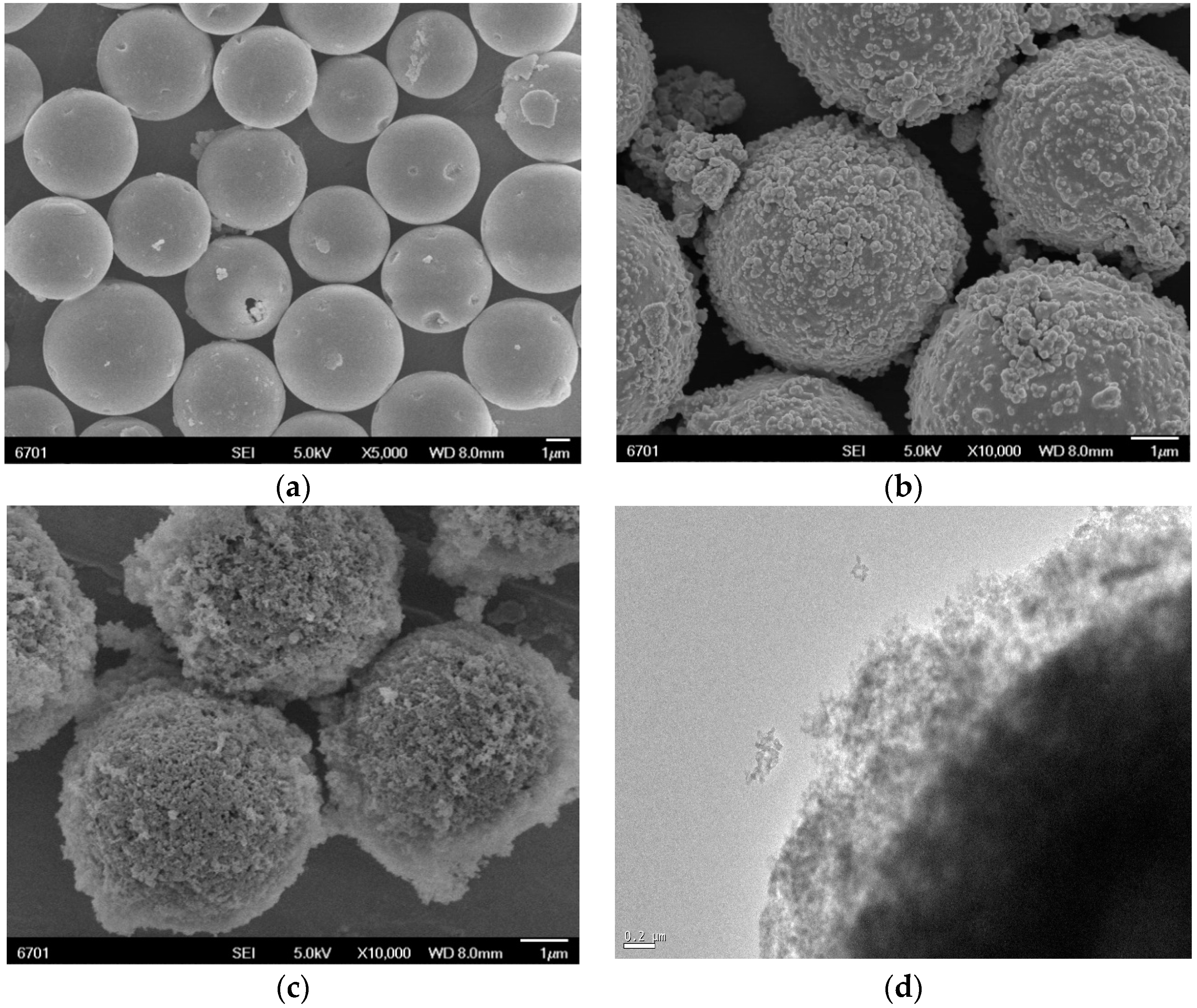
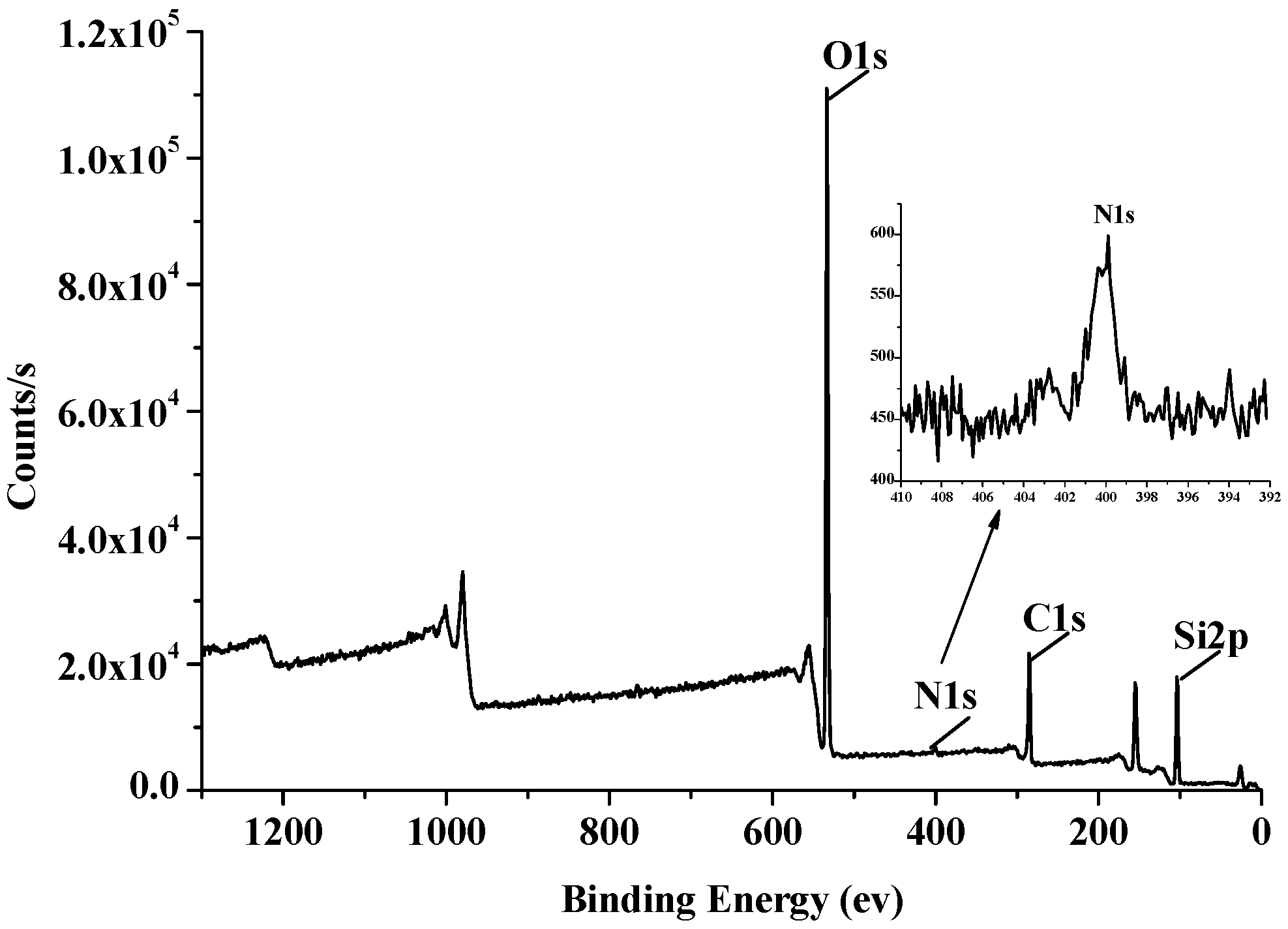

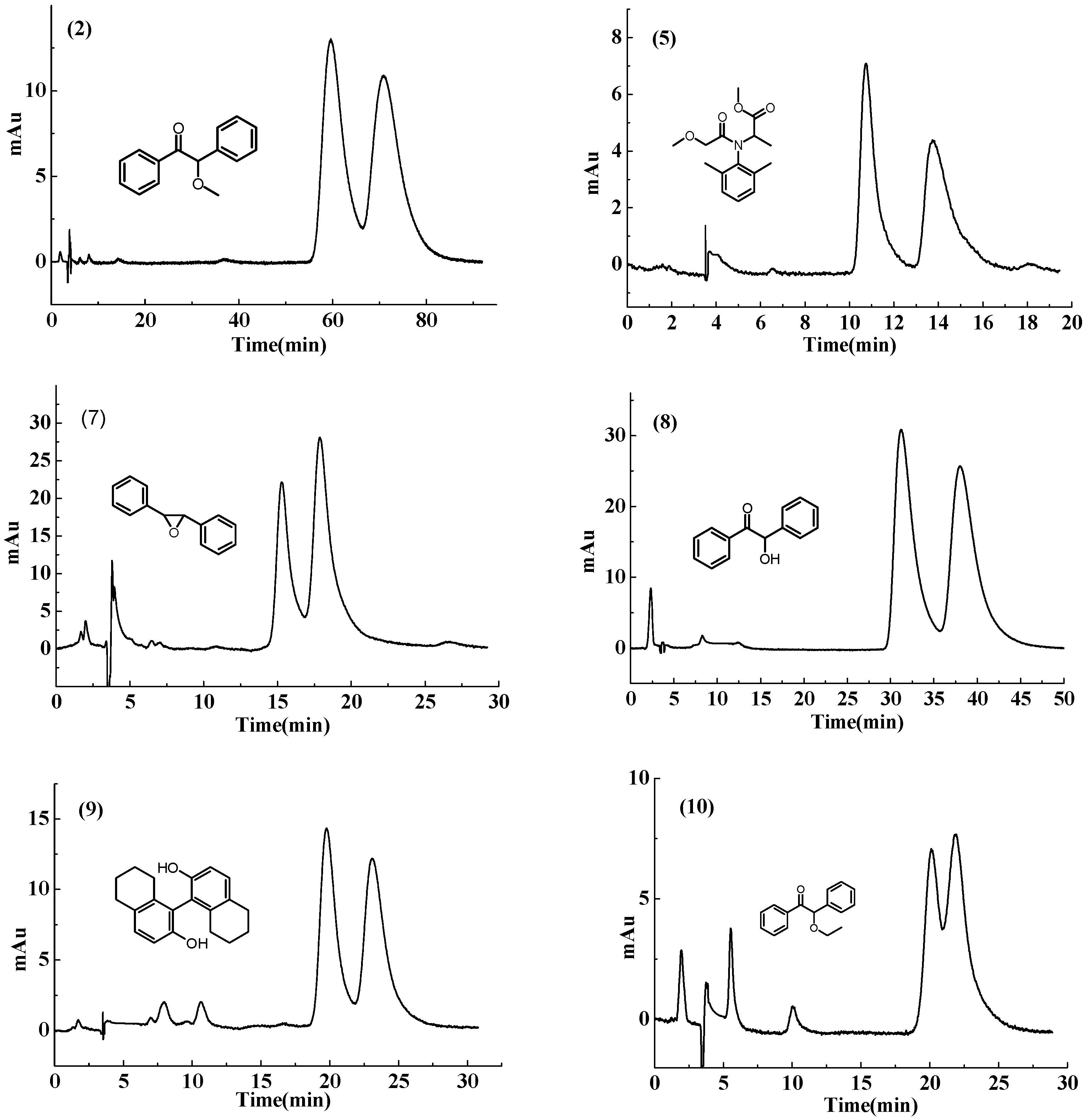
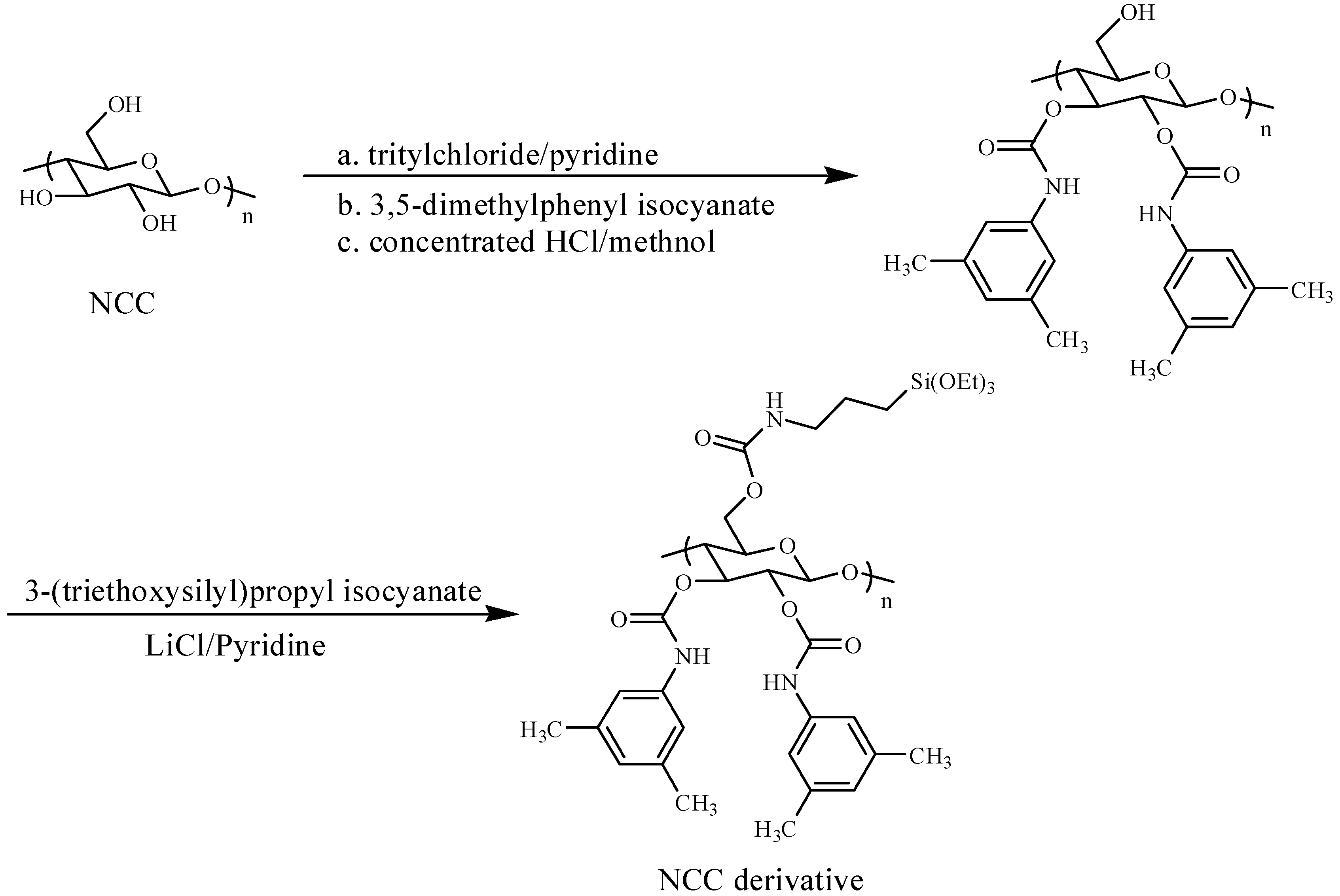
| Sample | Element Content (wt %) | ||
|---|---|---|---|
| N | C | H | |
| CPM1 | 0.12 | 2.95 | 0.76 |
| CPM2 | 0.21 | 3.58 | 0.90 |
| No. | Racemates | CPM2 Column | Chiralpak IB Column | ||||||
|---|---|---|---|---|---|---|---|---|---|
| k1 | k2 | α | Rs | k1 | k2 | α | Rs | ||
| 1 | 1-(1-Naphthyl) ethanol | 3.78 | 4.65 | 1.23 | 1.40 | 1.49 | 2.21 | 1.48 | 3.39 |
| 2 | Benzoin methyl ether | 2.22 | 2.66 | 1.20 | 1.11 | 2.09 | 2.84 | 1.36 | 3.38 |
| 3 | Diclofop | 0.73 | 1.49 | 2.05 | 3.17 | 0.87 | 1.90 | 2.19 | 7.48 |
| 4 | Ranolazine | 1.79 | 3.17 | 1.76 | 1.28 | 4.07 | 11.12 | 2.73 | 4.99 |
| 5 | Metalaxyl | 0.27 | 0.61 | 2.29 | 1.88 | 3.83 | 10.86 | 2.83 | 8.64 |
| 6 | 1-Phenylethanol | 1.42 | 1.97 | 1.39 | 1.68 | 0.65 | 0.72 | 1.11 | 0.24 |
| No. | Racemates | CPM2 Column | Chiralpak IB Column | ||||||
|---|---|---|---|---|---|---|---|---|---|
| k1 | k2 | α | Rs | k1 | k2 | α | Rs | ||
| 2 | Benzoin methyl ether | 26.68 | 31.91 | 1.20 | 1.13 | 4.25 | 4.69 | 1.10 | 1.36 |
| 5 | Metalaxyl | 3.99 | 5.38 | 1.37 | 1.62 | 1.68 | 2.28 | 1.36 | 2.61 |
| 7 | trans-Stilbene oxide | 6.09 | 7.30 | 1.20 | 1.13 | 22.41 | 23.06 | 1.03 | 0.61 |
| 8 | Benzoin | 13.50 | 16.64 | 1.23 | 1.36 | 2.92 | 3.32 | 1.14 | 1.58 |
| 9 | Octahydrobinaphthol | 8.07 | 9.63 | 1.19 | 1.42 | 3.25 | 3.64 | 1.12 | 1.38 |
| 10 | Benzoin ethyl ether | 8.33 | 9.17 | 1.10 | 0.73 | 3.69 | 3.90 | 1.06 | 0.76 |
| CHCl3 or THF /hexane(v/v) | Elution with CHCl3 | Elution with THF | ||
|---|---|---|---|---|
| α | Rs | α | Rs | |
| 0% | 1.22 | 1.39 | 1.22 | 1.39 |
| 25% | 1.18 | 1.37 | 1.18 | 1.16 |
| 50% | 1.17 | 1.37 | 1.17 | 1.20 |
| 100% | 1.18 | 1.39 | 1.16 | 0.99 |
© 2016 by the authors. Licensee MDPI, Basel, Switzerland. This article is an open access article distributed under the terms and conditions of the Creative Commons Attribution (CC-BY) license ( http://creativecommons.org/licenses/by/4.0/).
Share and Cite
Zhang, X.; Wang, L.; Dong, S.; Zhang, X.; Wu, Q.; Zhao, L.; Shi, Y. Nanocellulose Derivative/Silica Hybrid Core-Shell Chiral Stationary Phase: Preparation and Enantioseparation Performance. Molecules 2016, 21, 561. https://doi.org/10.3390/molecules21050561
Zhang X, Wang L, Dong S, Zhang X, Wu Q, Zhao L, Shi Y. Nanocellulose Derivative/Silica Hybrid Core-Shell Chiral Stationary Phase: Preparation and Enantioseparation Performance. Molecules. 2016; 21(5):561. https://doi.org/10.3390/molecules21050561
Chicago/Turabian StyleZhang, Xiaoli, Litao Wang, Shuqing Dong, Xia Zhang, Qi Wu, Liang Zhao, and Yanping Shi. 2016. "Nanocellulose Derivative/Silica Hybrid Core-Shell Chiral Stationary Phase: Preparation and Enantioseparation Performance" Molecules 21, no. 5: 561. https://doi.org/10.3390/molecules21050561





